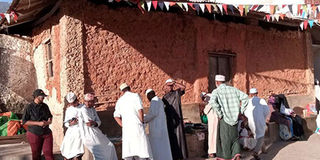Enduring structure that was home to a top Islamic mind

Residents of Lamu Old Town converge at Riyadha Mosque on November 21, 2019. The mosque was built in 1892. PHOTO | KALUME KAZUNGU | NATION MEDIA GROUP
What you need to know:
- The mosque, which began as a madrassa, is today one of the most prestigious and influential Islamic teaching institutions in the Swahili World.
- The centre of Maulid Festical is the Riyadha Mosque, where the East African version of the Maulid is believed to have been started by Swaleh.
In the compound of Riyadha Mosque in Lamu Island sits a mud-walled structure with corrugated iron sheet roofing.
The House of Habib Swaleh might not be impressive, but it has a rich history, dating back more than 120 years, having once been home to one of East and Central Africa’s most revered Islamic scholars.
Habib Swaleh, or Salih bin Alawi Jamal al-Layl, died in 1935 at the age of 83 years. He had family connections with the Hadhramaut in Yemen.
He was born in 1852 in Singani in the Comoro Islands, and grew up in an environment in which religion and academics were highly valued.
His father had initiated him into studying the Koran at a very tender age.
As a teenager, he and the famous Zanzibari scholar Sayyid Abubakar bin Ahmad bin Smeit were put under the tutelage of the great Comorian scholar Sayyid Muhammad bin Abdullah, alias Mwenye Ba Hassan.
'LITTLE MECCA'
Swaleh came to Lamu in 1870, aged 18 years, to visit his uncle, Sayyid Ali bin Abdullah Whad, and also to seek medication for an illness that had affected his legs.
While in Lamu, he studied under the island’s top scholars, including his uncle.
During his stay there, he became a highly-respected religious teacher and many students sought him out.
The House of Habib Swaleh and its contents bear testimony to the simple life of a pious man who became one of the most significant Islamic scholars of his time, and whose legacy lives on through the institutions and traditions he established.
One such institution is the Riyadha Mosque, built in 1892. It has been hailed as a landmark historical site because of its role in spreading Islam in the region.
The mosque, which began as a madrassa, is today one of the most prestigious and influential Islamic teaching institutions in the Swahili World, and is fondly referred to as “little Mecca”.
MAULID
It is known for hosting the annual Maulid Festival, which draws thousands of participants from different parts of the world.
The event is perhaps the best manifestation of the town’s religious heritage.
Over the last 100 years, the festival has gained prominence in the entire East and Central Africa, attracting thousands of visitors.
The centre of the festivities is the Riyadha Mosque, where the East African version of the Maulid is believed to have been started by Swaleh.
Today, the dilapidated House of Habib Swaleh, which measures 12 by 9 metres, remains an important feature.
For many Muslims who attend the festivities, the event is not complete without a visit to this house.
It inspires many and is a source of reference for many scholars and researchers.
It is one of the most important attractions during Maulid because that is the only time it is open to the public.
NATIONAL MONUMENT
Mr Mohammed Ali Mwenje, a curator with the National Museums of Kenya in charge of the Lamu Museums and Lamu World Heritage sites, says Lamu Old Town, which was gazetted in 1996 and declared a World Heritage Site by Unesco in 2001, is fully recognised for its important commercial role and attraction of scholars and teachers, which has made the town a centre of Islamic education and Swahili culture.
Mr Mwenje adds that Lamu’s prominent role in spreading Islam is largely attributed to the establishment of the Riyadha Mosque and its associated institutions.
In 2018, the government declared the Riyadha Mosque a national monument under the National Museums and Heritage Act.
Mr Mwenje says what remains now is the gazettement of the House of Habib Swaleh as an independent national monument, and that the process is already underway.
“The gazettement of the building will accord it the necessary protection and attract the necessary national and international resources for it restoration and maintenance. The building holds an important place in the history of Lamu Old Town,” he told the Nation.
Is there a site you want us to feature? Write an e-mail to [email protected].





